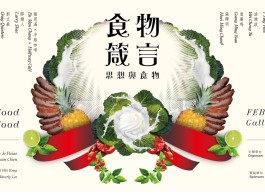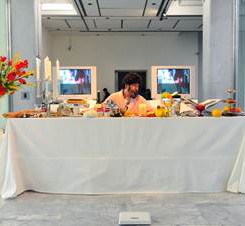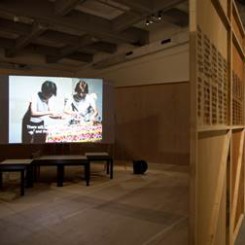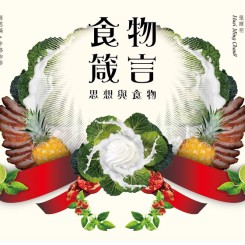Exhibition date: 2015.02.07 ~ 2015.05.03
Venue: Taipei Fine Arts Museum, Galleries 1A and 1B
Opening Hours: Tuesday to Sunday 9:30 – 17:30; extended hours to 20:30 on Saturday.
Closed on 02.18 and 02.19 (Chinese new year) and open at regular hours since 02.20
Curator: Jo Hsiao
Co-Curator: Boshin Chien
Participating Artists: Michael Lin, I Ting Hou, En Man Chang + Halfway Café, Wei Cheng Tu, Po Chih Huang, Hui Chiao Chen, Joyce Ho, Te Yu Wang, Huang Chen Tang + Tung Ning Hsieh, Goang Ming Yuan, Ming Hsueh Lee, Tung Shuo Wang, Larry Shao, Yu An Liao, Chi Yu Liao, Huei Ming Chang, Chi Wei Lin, Craig Quintero, Jun Jieh Wang, Jun Yang, Hsin Yu Liu, and Yi Wei Keng
The Testimony of Food: Ideas and Food returns to the true meaning of food at the Taipei Fine Arts Museum in February. Other than the usual debate on the food systems of foraging, ingestion, taste, and digestion of nutrients, the collection of 21 creators and artists has constructed a theatrical script based on the historical culture, social idea, and physiological function of “food” in order to explore the full ideological evolution of food in the individual and human society. These 21 creators attempt to fully upgrade the sensory experience of the exhibition through their artistic creations and performance projects to inspire the rich expressiveness and allure within the various forms of “food.”
The exhibition opens with Yi Wei Keng’s performance art titled Weight of Art at the north gallery of the TFAM ground floor. Keng plays the main character from the movie The Cook, The Thief, His Wife and Her Lover(1989) and lays out the foods of the exhibition on the big dining table in front of the audience. He would first weigh in before the performance, start eating in a competitive manner, and then weight out to see how much weight he gained. During the performance, video is played back at the same time to emphasize the various food shows and media reports – food is the miniaturized “La Société du spectacle.”
This opening not only aims to introduce the curatorial theme and content, but also stimulates the audience from the perspective of art history and social history – to think about the relationship between food and art – in this live performance for the testimony of food.
Curator Jo Hsiao, on her curatorial concept, mentioned that this is an “exhibition full of temptation” with 8 scenes of “Belief,” “Desire,” “Culture,” “Memory,” “Relationship,” “Depravity,” “Knowledge,” and “Consume” to elaborate on the sensory experience of food. Food is an active participant in the human society that stimulates our senses of taste, touch, vision, and smell. Its voodoo power arouses the body and soul through the human mind and sensory system. As a multilayered symbolism on the cultural, physical, and social levels, food is now more closely related to us humans even more than ever. The 21 participating works and performance projects of The Testimony of Food: Ideas and Food from Michael Lin, I Ting Hou, En Man Chang + Halfway Café, Wei Cheng Tu, Po Chih Huang, Hui Chiao Chen, Joyce Ho, Te Yu Wang, Huang Chen Tang + Tung Ning Hsieh, Goang Ming Yuan, Ming Hsueh Lee, Tung Shuo Wang, Larry Shao, Yu An Liao, Chi Yu Liao, Huei Ming Chang, Chi Wei Lin, Craig Quintero, Jun Jieh Wang, Jun Yang, Hsin Yu Liu, and Yi Wei Keng have given food the right to speak up at this exhibition. Different characters play out the 8 scenes at the food theatre to present an extreme and spiritual experience of “food enlightenment” to the viewers.
[Food Theatre] Scene 1: Belief
Halfway Night Recipe –Under Construction from Halfway Café works on the philosophy of national independence to regurgitate the environment and society through food and consciously obtain the perspective of a community measured through food. Artist En Man Chang has then defined the exhibition as a publishing project by inviting the store managers and chefs of “Halfway Café” to interface with a recipe by transforming vegetarianism, penny gourmet, food and drinks into an ideological belief.
[Food Theatre] Scene 2: Desire
Ming Hsueh Lee’s Sugar Ring features the oversized object as an alias of desire to exist by paying tribute from below. The “object” in Joyce Ho’s single channel video installation Overexposed Memory was transformed from its original form as an expression of the violence of excessive desires. Te Yu Wang’s mixed media audio work No. 78 materializes his body into the reagents of desires, where the excessive belches are slow responses to the bottomless desires of the unbalanced physiological system.
[Food Theatre] Scene 3: Culture; Scene 4: Memory
Performance artist Huang Chen Tang and theatre director Tung Ning Hsieh’s use of 4 scripts to interpret 4 individual performances of “DEVENIR” for the destruction and reconstruction of the boundaries of food hidden under the ideologies. Like making lasagna from kneading, rolling, and forming the dough, “DEVENIR” implies that food itself is an ideology that is constantly flowing and changing, shimmering with the light of self-consciousness. Jun Yang’s Eat Drink Art Business brings Asian food to Vienna by allowing the space itself to take presence, regardless of the wide variety of food and drinks sold in the restaurant. By returning food to framework of everyday diet, he evokes intense shared memories and sentiments to transcend time and distance within the food’s own lineage.
[Food Theatre] Scene 5: Relationship
From the perspective of modern psychology, food brings about the power between human-human and human-deity relationships. Food describes a complex equation where love and hate, sincerity and distain can coexist within the same ceremony. Goang Ming Yuan’s Prophecy features a neatly set dining table to imagine a scene filled with silence and static. The static silence is even more so infectious when sounds and wild shaking break into the space, when the artist is able to freeze frame on the relation between people as revealed by the well arranged dining table. Tung Shuo Wang’s The Universe is an abstract painting of the dining table stocked with offerings to our ancestors and gods, and our relations with them in the process. The food in Craig Quintero’s Food Fight photography series seems to ignite an uncontrollable conflict deep within us and to reflect the true feelings behind the moral principles of sharing food. While chocolate is often used as a metaphor of love, Wei Cheng Tu’s mixed media installation Happy Valentine’s Day makes chocolate into weapons to declare a devastating destructive force as manifestation of the cruel opposition between people.
[Food Theatre] Scene 6: Depravity
Balzac on tobacco in Traité des excitants moderns said that, “We had no idea that being a chimney can bring such pleasure.” Excitement, paralysis, obsession, pause are the physical experience of Chi Wei Lin during the creation of Psychedelic Painting Series. Hui CHiao Chen’s Poppy installation provides a visual seduction to titillate and turn the viewer’s impulsion. The mysterious powers of destruction and rebirth from the poppy and various psychedelic flowers that one could only fantasize before are now presented in full view. Po Chih Huang’s Protein Boy is a short novel about being infatuated with food and sex to connect the two basic human needs. In fact, tobacco and protein are both self releasing and self destructing treatments of the soul only achievable through food.
[Food Theatre] Scene 7: Knowledge
Huei Ming Chang’s single channel video Apple Tree takes inspiration from the “fruit of knowledge” in the Book of Genesis to initiate the material and abstract thinking as presented by the three different materials on the apple tree. As a creator and salsa dance, Larry Shao combines social networking with aerobics to integrate the knowledge of physiology and healthy food into everyday lives. His Vida Salsa – A Salsero Lifestyle APP combines food and dancing for a healthy lifestyle that is freely available for download. Yu An Liao’s symbolic birdman totem features a series of cartoon drawings to mock the common praise of modern healthy diets – where excessive control and indulgence of food has defined the health knowledge of this era as advocated by the health experts and nutritionists.
[Food Theatre] Scene 8: Consume
Our primitive desire for materials is to “consume.” As a consumer of the market of food including imperial cuisine, crème brulee, coffee, or vegetables, everything we consume is manufactured to a profit and loss baseline. In this era, we can finally put our faith in food in order to supply all tastes that conform to the modern buds. Jun Jieh Wang’s Little Mutton Dumplings for the Thirteenth Day brings the ancient Chinese imperial cuisine into the middle-class consumer market. Michael Lin’s Cool Sweet vendor bicycle sells a type borderless coffee and sweets. As a stimulant of modern life, coffee and sweets have consistently and repeatedly fed the endless desires of our daily diet. Hsin Yu Liu’s black and white photography Super Market instinctively captured the gradually decomposing fruits and vegetables to boldly criticize the market supply chain under capitalism with still images without muttering a single word.
The Testimony of Food: Ideas and Food is now on exhibition on the ground floor of Taipei Fine Arts Museum from February 7th to May 3rd covering a series of performance projects, lectures, shows, photography, performances, and recitations etc. The exhibition begins at 16:30 of February 7th in the Halfway Café TFAM branch (Halfway Cafe Late Night Recipe – Under Construction), where store manager Tsi Hsuan Yang of the Halfway Café Gongguan branch shares their business philosophy for the “Night Canteen” and launches the “Halfway Currency.” Throughout the exhibition, performance artist Huang Chen Tang and theatre director Tung Ning Hsieh will schedule four performances titled “DEVENIR.”




